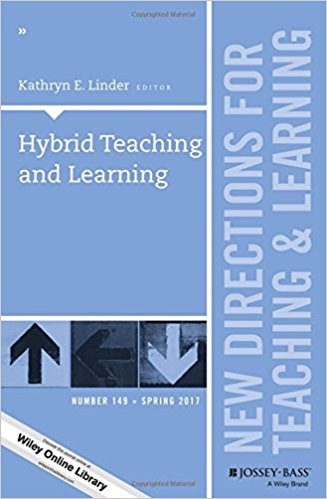
Hybrid Teaching and Learning: New Directions for Teaching and Learning, Number 149
Date Reviewed: December 12, 2017
Hybrid Teaching and Learning defines and explains the hybrid approach to teaching and learning by providing answers to questions surrounding this phenomenon. This method of teaching and learning is often referred to as blended pedagogy. Answers to questions and conclusions are arrived at through eleven chapters that together give a strong and comprehensive explanation of hybrid teaching and learning. The authors of the chapters are Kathryn E. Linder, Patsy D. Moskal, Linda S. Bruenjes, Sarah A. Smith, Traci Stromie, Josie G. Baudier, Jason Snart, Faye Haggar, Bruce Kelley, Weichao Chen, Daniel Newman, Michael Dickinson, and Kirsten Behling.
Kathryn E. Linder defines hybrid teaching as a pedagogy that utilizes technology to create a variety of learning environments for students (11). This method of teaching and learning reduces the amount of face-to-face encounters between teacher and learner. However, technologically facilitated activities outside of the actual classroom often make the face-to-face meetings more active and meaningful. The teacher of hybrid courses must be intentional in setting up these activities.
Each chapter describes its objective clearly and explains it very well for the reader. The pedagogy of hybrid teaching and learning has components similar to other successful pedagogies, including learning outcomes and objectives. A best practice in hybrid pedagogy is to start at the end and work backwards in planning courses. One should know what the desired final outcome is before planning activities. This type of teaching and learning involving backward design requires planning the entire course and may be difficult for teachers who are accustomed to planning classes weekly.
This book works well as a framework for understanding hybrid teaching and learning. It is very timely for institutions considering a variety of methods for instruction. The authors suggest ways of keeping the values that come with face-to-face teaching and learning while taking advantage of the many new technologies that enhance teaching and learning.
I found chapter 9 to be of particular interest because the author makes a strong argument to teachers about accessibility. Teachers of hybrid courses must ensure that all students can access courses in face-to-face spaces as well as technological spaces. The only weakness that I can identify in this book is that perhaps it could have given more information or insight about the pros and cons of hybrid teaching and learning. This might help others avoid some pitfalls.
Overall, I found this book to be a valuable asset. As one who uses hybrid pedagogy I think this book is a helpful tool for all teachers who prepare and plan to teach in this format. Individual chapters or the entire book will help others learn more about hybrid teaching and learning.